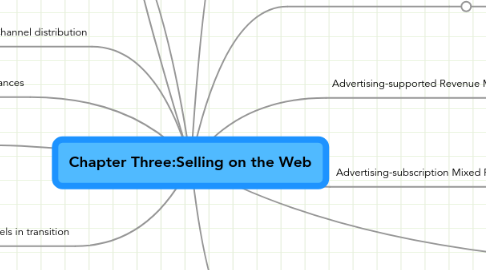
1. Revenue Models
1.1. B2B
1.2. B2C
2. Revenue Models in transition
2.1. Subscription to Advertising-Supported Model
2.1.1. Slate magazine
2.2. Advertising-supported to Advertising-subscription Mixed Model
2.2.1. Salon.com
2.3. Advertising-supported to fee-for-services Model
2.3.1. Xdrive tech
2.4. Advertising-supported to subscription model
2.5. Multiple transitions
2.5.1. Encyclopedia Britannica
3. Revenue Strategy Issues
3.1. Channel conflict
3.1.1. Web sales interfere with existing outlets
3.2. Cannibalization
4. Strategic Alliances
4.1. joining forces
5. Channel distribution
5.1. Companies responsible for product line within a retail store
5.2. specializes in the product
6. WEB Presence
6.1. Is about what the customer needs and not the company
6.2. content
6.2.1. C.A.R.T
6.3. Useability
6.3.1. search features
6.4. Design
6.4.1. appealing
6.5. Security
6.5.1. gaining trust
6.6. Navigation
6.6.1. Ease to use
6.7. Forms
6.7.1. Not to many but enough
6.8. Policies
6.8.1. making safe and secure
7. Web catalog Revenue Models
7.1. Putting catalog on web
7.2. Place orders
7.2.1. Web site
7.2.2. Phone
7.3. Only works for certain industries
7.3.1. Sears
7.3.1.1. catalog orders
7.3.2. CDnow
7.3.2.1. Music
7.3.3. Barnes & Noble
7.3.3.1. Books
7.3.4. Proflowers.com
7.3.4.1. Flowers
8. Digital Content Revenue Models
8.1. Information Services
8.1.1. Legal info
8.1.2. gov't news
8.1.3. academic libraries
9. Advertising-supported Revenue Models
9.1. Similar to Network TV
9.2. Broadcasters provide free programming
9.2.1. Advertisers pay for spots
9.3. Web portal
9.3.1. Google
9.3.2. AOL
9.3.3. MSN
10. Advertising-subscription Mixed Revenue Models
10.1. Subscribers pay a fee
10.2. Advertising for the rest
10.2.1. Newspapers
11. Fee-for-Transaction revenue Models
11.1. Pay dependent on
11.1.1. number of transactions
11.1.2. size of transactions
11.2. Disintermediation
11.2.1. removing the agent
11.2.1.1. Travel agents
11.2.1.2. Auto sales
11.2.1.3. Buying stocks
11.2.1.4. Buying insurance
12. Fee-for-Service Revenue Models
12.1. Pay for service provided
12.1.1. Online Games
12.1.2. Concert and Films
12.1.3. Professional service
